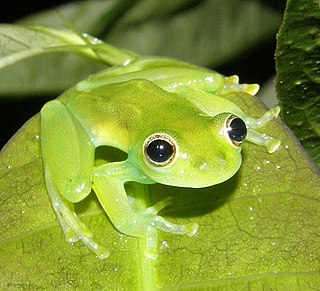Related Research Articles

Capparis spinosa, the caper bush, also called Flinders rose, is a perennial plant that bears rounded, fleshy leaves and large white to pinkish-white flowers.

The northern jacana or northern jaçana is a wader which is a resident breeder from coastal Mexico to western Panama, and on Cuba, Jamaica and Hispaniola in the Caribbean. It sometimes breeds in Texas, United States, and has also been recorded on several occasions as a vagrant in Arizona. The jacanas are a group of wetland birds, which are identifiable by their huge feet and claws, which enable them to walk on floating vegetation in the shallow lakes that are their preferred habitat. In Jamaica, this bird is also known as the 'Jesus bird', as it appears to walk on water. Jacana is Linnæus' scientific Latin spelling of the Brazilian Portuguese jaçanã, pronounced [ʒasaˈnɐ̃], from the Tupi name of the bird. See jacana for pronunciations.

Teratohyla spinosa is a species of frog in the family Centrolenidae. It is found in the Pacific lowlands of northern and central Ecuador and western Colombia, northward on the Pacific slopes Panama and Costa Rica, as well as on the Caribbean slopes of Costa Rica, Nicaragua, and Honduras.

Quasipaa spinosa is a species of frog in the family Dicroglossidae. It is known under many common names, including Chinese spiny frog, giant spiny frog, Chinese edible frog, and spiny paa frog. Its names refer to the distinctive characteristics of the species, relatively large size and the spiny chest of male frogs. Giant in frog terms only, it can nevertheless grow to lengths above 10 cm (4 in); this makes it the largest frog in Hong Kong.

Grayia is a genus of plants in the subfamily Chenopodioideae of the family Amaranthaceae. Common names are siltbush and hopsage. The four shrubby species occur in arid and semiarid regions of western North America:

Grayia spinosa is a species of the genus Grayia in the subfamily Chenopodioideae of the flowering plant family Amaranthaceae, which is known by the common names hop sage and spiny hop sage. It is widely distributed across the Western United States, where it grows in a number of desert and mountain habitats.

Alsophila aescularia, the March moth, is a species of moth of the family Geometridae. It is found throughout Europe and can be a pest of fruit trees.

Cephonodes hylas, the coffee bee hawkmoth, pellucid hawk moth or coffee clearwing, is a moth of the family Sphingidae. The species was first described by Carl Linnaeus in 1771. A widely distributed moth, it is found in the Near East, Middle East, Africa, India, Sri Lanka, Japan, Southeast Asia and Australia.

The March dagger moth is a moth of the subfamily Chimabachinae. It is found in Europe and was first described by Michael Denis & Ignaz Schiffermüller in 1775.

The tawny mining bee, Andrena fulva, is a European species of the sand bee (Andrena) genus. The males are 10–12 mm (0.4–0.5 in) and the females 8–10 mm (0.3–0.4 in) long. The female is covered with fox-red hair on the dorsal surface of its thorax and abdomen and black hair on its head and ventral surface. The male is less distinctive, being clad in golden-brown or reddish-brown hairs, with some long white hairs on the face, and a tooth on each of the mandibles.

Mirificarma cytisella is a moth of the family Gelechiidae. It is found from most of Europe to the Ural Mountains.

Eucrostes indigenata is a moth of the family Geometridae first described by Charles Joseph Devillers in 1789. It is found in the Mediterranean region, inland up to North Macedonia and Hungary. Subspecies lanjeronica is found in southern Spain and Algeria.

Gynaephora selenitica is a moth in the family Erebidae first described by Eugenius Johann Christoph Esper in 1789. It is found from central Europe through eastern Europe to the Urals. It is not found in western and southern Europe and Scandinavia.
Habroteleia is a genus of parasitic wasps in the family Platygastridae. There are about 9 described species in Habroteleia.

Habroteleia flavipes, is a species of wasp belonging to the family Platygastridae.
Habroteleia mutabilis, is a species of wasp belonging to the family Platygastridae. It is described from Fiji.
Habroteleia ruficoxa, is a species of wasp belonging to the family Platygastridae. It is found in Philippines.
Habroteleia salebra, is a species of wasp belonging to the family Platygastridae. It is described from Papua New Guinea and Indonesia.
Habroteleia soa, is a species of wasp belonging to the family Platygastridae. It is the most geographically disjunct member of the genus, which is separated by other members by the Indian Ocean. It is found in Papua New Guinea and Indonesia.

Libinia spinosa is a majoid crab found in mud and sand bottoms of the Southwestern Atlantic and Pacific oceans. It is a generalist feeder on organisms such as algae, sponges, cnidarians, mollusks, polychaetes, crustaceans, and small fish. It commonly engages in a symbiotic relationship with the medusa Lychnorhiza lucerna.
References
- 1 2 3 Chen, H. Y.; Talamas, E. J.; Masner, L.; Johnson, N. F. (17 January 2018). "Revision of the world species of the genus Habroteleia Kieffer". ZooKeys (730): 87–122. doi: 10.3897/zookeys.730.21846 . PMC 5799745 . PMID 29416398 . Retrieved 3 April 2018.